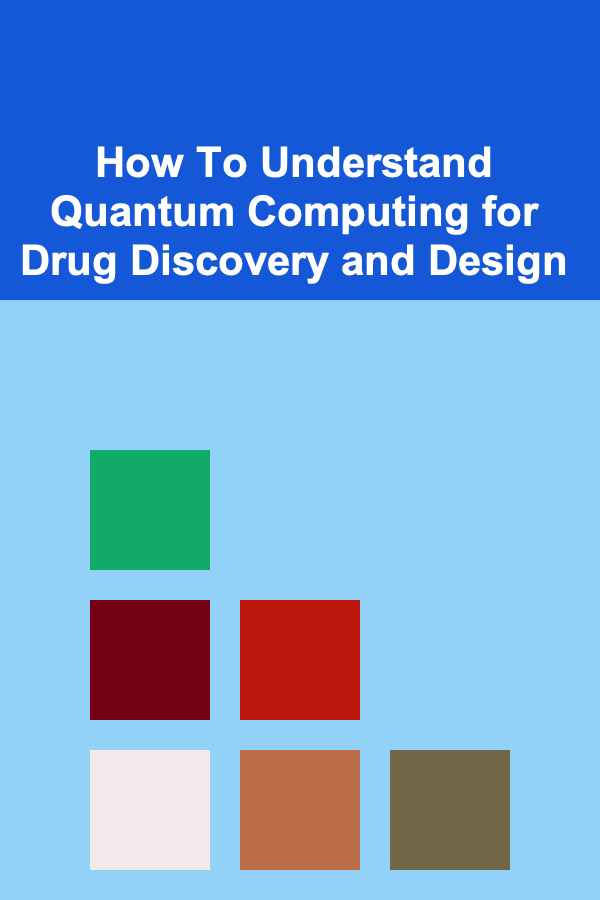
How To Understand Quantum Computing for Drug Discovery and Design
ebook include PDF & Audio bundle (Micro Guide)
$12.99$8.99
Limited Time Offer! Order within the next:

Quantum computing, a field that holds the potential to revolutionize multiple industries, has garnered particular interest in the world of pharmaceutical research, especially in drug discovery and design. By harnessing the peculiar properties of quantum mechanics, quantum computers promise to tackle some of the most complex problems in molecular biology, chemistry, and pharmacology. But how exactly can quantum computing transform drug discovery? This article explores the fundamentals of quantum computing, its application in drug discovery, and the opportunities it offers for the future of pharmaceutical research.
The Basics of Quantum Computing
Quantum computing is a type of computation that uses quantum bits, or qubits , as opposed to the classical bits used in traditional computing. In classical computing, a bit can either be 0 or 1, representing two possible states. A qubit, however, can exist in multiple states simultaneously, thanks to the principle of superposition. This allows quantum computers to perform many calculations in parallel, vastly improving their computational power for certain types of problems.
Another crucial quantum property is entanglement. When qubits become entangled, the state of one qubit can depend on the state of another, even if they are separated by large distances. This property enables faster data processing and enhanced problem-solving capabilities.
For drug discovery, these quantum properties offer the potential to simulate the behavior of molecules and proteins with much greater accuracy than classical computers can manage, opening up new pathways to understanding complex biological systems.
Traditional Drug Discovery and Its Limitations
Traditionally, drug discovery involves several stages, starting with the identification of a biological target, such as a protein, and then finding molecules that can interact with that target. The process typically includes high-throughput screening , where thousands or even millions of compounds are tested for activity against the target. This is followed by hit identification , lead optimization , and clinical trials. While this process has led to many groundbreaking treatments, it is often slow, expensive, and inefficient.
One of the main challenges in traditional drug discovery is the complexity of biological systems. Proteins, which are often the targets of drugs, fold into three-dimensional shapes that are critical for their function. Understanding how a drug will interact with a protein requires simulating how the protein folds and how molecules bind to it. Classical computers struggle to model the intricate interactions at the atomic level due to the vast number of variables involved.
The Role of Quantum Computing in Drug Discovery
Quantum computing presents a way to overcome the limitations of classical computing in drug discovery. By leveraging quantum mechanics, researchers can simulate molecular interactions at an unprecedented level of detail. Quantum computers have the potential to accelerate the entire drug discovery process, from target identification to lead optimization.
3.1 Quantum Simulations of Molecular Interactions
Molecular simulations are at the heart of drug discovery. Understanding how a drug molecule interacts with a protein target requires simulating the molecular dynamics of both entities. In classical computing, this is an intractable problem due to the exponential growth of possible configurations as the size of the system increases. Quantum computing, on the other hand, can naturally simulate quantum systems with a much higher level of precision.
Using quantum algorithms, researchers can simulate how electrons move within molecules, predict molecular properties, and optimize drug design. Quantum computers could model the behavior of molecules in ways that classical computers simply cannot, allowing for faster and more accurate predictions of how a drug will interact with its target.
3.2 Drug Target Identification
One of the first steps in drug discovery is identifying biological targets that play a key role in disease. Quantum computing can aid in this process by enabling researchers to analyze large datasets of biological information, including genetic, protein, and cellular data. By applying quantum machine learning techniques, researchers can uncover hidden patterns in these complex datasets and identify potential drug targets that may have been overlooked using traditional methods.
Quantum algorithms can process vast amounts of data simultaneously, allowing researchers to mine complex biological information much more efficiently. This has the potential to speed up the process of target identification and enable the discovery of new drug targets that could lead to the development of more effective treatments.
3.3 Protein Folding and Structure Prediction
Protein folding is one of the most challenging problems in biochemistry and is central to drug discovery. Proteins are long chains of amino acids that fold into specific three-dimensional structures, which determine their function. Misfolded proteins are often associated with diseases like Alzheimer's and Parkinson's.
Quantum computers can simulate protein folding with greater precision than classical computers, thanks to their ability to model quantum interactions at the atomic level. Quantum algorithms can predict protein structures by considering the quantum mechanical effects on the folding process. This could lead to better understanding of how proteins fold and how they can be manipulated to treat diseases. Faster and more accurate protein structure prediction would also accelerate the development of drugs that target specific proteins, potentially reducing the time and cost required to bring new drugs to market.
Quantum Computing and Drug Design: A New Paradigm
Drug design involves identifying molecules that can interact with biological targets to produce a therapeutic effect. The process requires testing vast libraries of compounds to identify potential drug candidates. Classical computers often rely on brute-force methods, screening large numbers of compounds and testing their interactions with target proteins. While effective, this method is time-consuming and resource-intensive.
Quantum computing can transform drug design by offering more efficient algorithms for virtual screening and molecular docking. Virtual screening involves predicting how well a drug molecule will bind to a protein target, while molecular docking simulations help predict the optimal orientation of the drug molecule within the protein's binding site. Quantum computers can perform these simulations more efficiently, enabling the rapid identification of drug candidates.
4.1 Quantum-enhanced Machine Learning for Drug Design
Machine learning (ML) is a powerful tool used in drug discovery to predict the properties of drug candidates and optimize lead compounds. Quantum computing can enhance machine learning models by providing more accurate simulations of molecular systems. Quantum machine learning algorithms are designed to leverage quantum properties like superposition and entanglement, enabling them to process and analyze large datasets much faster and more accurately than classical models.
Quantum-enhanced machine learning could enable faster drug design by improving the accuracy of predictions regarding molecular interactions, toxicity, and efficacy. By training quantum machine learning models on large datasets, researchers could optimize drug candidates more effectively, reducing the need for trial-and-error experimentation.
4.2 Quantum Annealing and Optimization
Quantum annealing is a technique that can be used for solving optimization problems, which are common in drug design. Optimization problems arise when researchers need to find the best possible molecular configuration, such as the most stable drug binding to its target or the most efficient synthesis pathway for a drug. Classical optimization algorithms often require significant computational resources and time to explore all possible solutions.
Quantum annealing, particularly on quantum hardware like D-Wave systems, can perform optimization tasks much more efficiently by leveraging quantum tunneling to explore multiple solutions simultaneously. This makes it an ideal tool for finding optimal drug candidates faster, improving the efficiency of the drug design process.
Challenges and Future of Quantum Computing in Drug Discovery
Despite the exciting potential of quantum computing in drug discovery, there are still several challenges that must be overcome before it becomes a mainstream tool in pharmaceutical research.
5.1 Hardware Limitations
Current quantum computers are still in the early stages of development. The qubits in these systems are prone to errors, and scaling up quantum hardware to handle complex drug discovery simulations remains a significant challenge. Researchers are working on improving quantum error correction techniques and developing more robust quantum systems, but these advancements will take time.
5.2 Algorithm Development
While quantum computing holds immense promise, the development of quantum algorithms that can outperform classical algorithms in real-world drug discovery applications is still in its infancy. Many quantum algorithms are theoretical, and much research is needed to translate them into practical solutions that can be used in drug discovery.
5.3 Integration with Classical Systems
To be effective, quantum computing needs to integrate seamlessly with classical computing systems, as most drug discovery workflows currently rely on classical computers. Researchers will need to develop hybrid approaches that combine the strengths of both quantum and classical systems to achieve optimal results.
Conclusion
Quantum computing has the potential to revolutionize drug discovery and design by providing unprecedented computational power and enabling simulations that were previously impossible. By simulating molecular interactions, predicting protein structures, enhancing machine learning models, and optimizing drug design, quantum computers could dramatically accelerate the drug discovery process and lead to the development of more effective treatments for a wide range of diseases.
However, there are still many challenges to overcome before quantum computing becomes a mainstream tool in drug discovery. As quantum hardware and algorithms continue to evolve, the pharmaceutical industry may be on the cusp of a new era in drug research---one in which quantum computing plays a central role in shaping the future of medicine.
The future of drug discovery is bright, and quantum computing is at the forefront of this transformative shift. While we are still in the early stages, the possibilities are vast, and the potential impact on human health could be profound. As quantum technology advances, we may soon see a world where the treatment of diseases is faster, more efficient, and more precise, ushering in a new era of personalized medicine.

How To Build a DIY Bird Blind
Read More
How to Measure the ROI of LinkedIn Marketing for Your B2B Dropshipping Business
Read More
How to Renovate on a Tight Timeline
Read More
Mastering Software Architecture: Essential Skills for Modern Architects
Read More
Unlocking the Secrets of Market Research: Tools and Techniques for Success as a Research Analyst
Read More
How To Offer Website Design Services: A Comprehensive Guide
Read MoreOther Products

How To Build a DIY Bird Blind
Read More
How to Measure the ROI of LinkedIn Marketing for Your B2B Dropshipping Business
Read More
How to Renovate on a Tight Timeline
Read More
Mastering Software Architecture: Essential Skills for Modern Architects
Read More
Unlocking the Secrets of Market Research: Tools and Techniques for Success as a Research Analyst
Read More